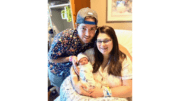Dr. Danny Branstetter, a physician with Wellstar Health System and an expert on infectious disease and COVID-19, spoke to the Courier about what we know about COVID-19 on this one-year anniversary since the first cases were uncovered in Georgia.
“We learned a year ago by announcement of Governor Kemp that the State of Georgia had its first cases of COVID-19,” Branstetter said. “So here we are, 12 months later, still learning about this virus and treatments, diagnosis, and presentation.”
“Unfortunately, 500,000 deaths later in the United States, and we are still trying to get the vaccine in enough people’s arms to protect our communities,” he said. “And we are still learning about what’s the most effective treatment and who’s most at risk for this disease.”
Branstetter said there are a few things that physicians have learned work very well when treating COVID-19.
He said when the pandemic began, it was difficult to get the tests. He said medical professionals have better access to the tests, and have learned to interpret the test results better.
“And that’s the diagnosis part,” Branstetter said.
He said that in terms of treatment, medical professionals are still learning a lot.
“We know few things work,” he said.
“For those who need oxygen, we know that steroids are really good therapy,” he said. “We also know that having people lie on their bellies, called ‘proning’ is a very good intervention to prevent progression and help with keeping the oxygen levels up.”
“We also have some effective therapies that are showing promise for treating outpatient, called ‘monoclonal antibodies‘. Those are looking very strong when used very early in the course of disease,” said Branstetter.
“The thing we do not have is a universal treatment, for everyone, no matter where they show up in the phase of their illness,” he said.
Changes in health care brought on by COVID-19
The Courier asked Dr. Branstetter what changes had occurred in health care delivery since the onset of the COVID-19 pandemic.
“Most profound, and probably here to stay in health care delivery, are virtual visits and telehealth,” he said.
Branstetter said that telehealth was rare in the past, and mostly used for counseling.
“But now, I think it’s become more commonplace,” he said. “And I think that field of medicine will continue to grow.”
He said in-person visits are still a necessary part of treatment, though.
“(Telehealth) has a lot of valuable tools, but certainly does not replace in-person visits that will be needed,” said Branstetter. “
“For in-person visits. I think screening questionnaires, (and) individualized understanding of risk factors, have increased during this pandemic.”
He said the pandemic also focused attention on the need to increase the access to health care for people who have historically had barriers to care.
Is there still a drop-off in people seeking care due to fear of COVID-19?
The Courier asked if people with preexisting conditions and chronic illnesses were still reluctant to schedule visits to physicians out of fear of COVID-19, as they were early in the pandemic.
“I think number one is we’re still seeing hesitancy seeking care and (patients are) delaying care,” he said. “I’m still seeing a lot of people present with advanced illness or condition because of delays in care, concerned about getting COVID-19 if they seek care.”
“One of the things, though, that has come out that’s very positive about this is we’ve developed very strong relationships with partners: faith based community leaders and civic leaders, and the Department of Public Health, to really do outreach to those communities who have had less access, and less connection with health care historically,” said Branstetter. “So those are growing, and I am very proud to say that I do think that that is going to be a very good benefit.”
Dr. Branstetter said this reluctance to seek care isn’t just limited to infectious diseases.
“We’re dealing with some epidemics within our own society that are not infectious,” he said. “We have an obesity epidemic, we have a lack of nutrition and healthy eating as an epidemic in a lot of our communities.
“So these things we need to continue to work on,” he said. “And this pandemic has really laid bare those inequities.”
“And I think this partnership has really allowed us to shore up what it really means to keep people healthy and to address health in our community,” he said.
Vaccine rollout and availability problems
Asked whether the problems with the COVID-19 rollout were likely to continue, he said, “I’m encouraged by the reports of increased availability, increased production.”
“Certainly it has lagged. That’s no secret. I don’t think anyone would contradict that,” he said.
He said the recent severe weather had added to the difficulty getting the vaccine out.
“The very encouraging news, though, is that we have a third vaccine that’s very effective available now to us, and will provide more options and more volume of vaccines available to our communities,” he said. “So that’s encouraging news.”
“The predictions of increased availability and manufacturing are that we’ll see more and more in the coming weeks or months,” Branstetter said.
Trends in deaths and hospitalizations
The Courier asked Dr. Branstetter if he saw any good news in terms of deaths and hospitalizations from COVID-19.
“Unfortunately, I am not happy with where our death and mortality rates are,” he said. “The numbers of new infections and hospitalizations have improved since earlier in the year.”
“Hospitalizations have not improved as much as the numbers of new infections have,” Branstetter said.
“And then lastly, we’re still seeing and setting really high numbers of deaths per day, probably a lagging metric of our surge that happened over December and January.”
The importance of community partnerships
“I think the highlights are the importance of partnerships, because it’s it took a whole community to really help us get through this,” he said. “And we’re still not done.”
“It took essential workers of all kinds: grocery store clerks, sanitation workers, teachers, and public health officials,” he said. “(It took) all these to really make this go and make us survive and thrive during this pandemic.”
“And remember,” he said. “We’re still learning.”
“This is a novel virus. It has thrown us many curveballs and taken many twists and turns in our story,” he said. “We’re learning a lot, but there is still much more to figure out, and I really want the readership to know that we still have a long way to go, despite great news on a vaccine.”
“Some therapies are showing some help in this disease, but still need to do the prevention measures, because that’s our best treatment right now,” Dr. Branstetter said.





